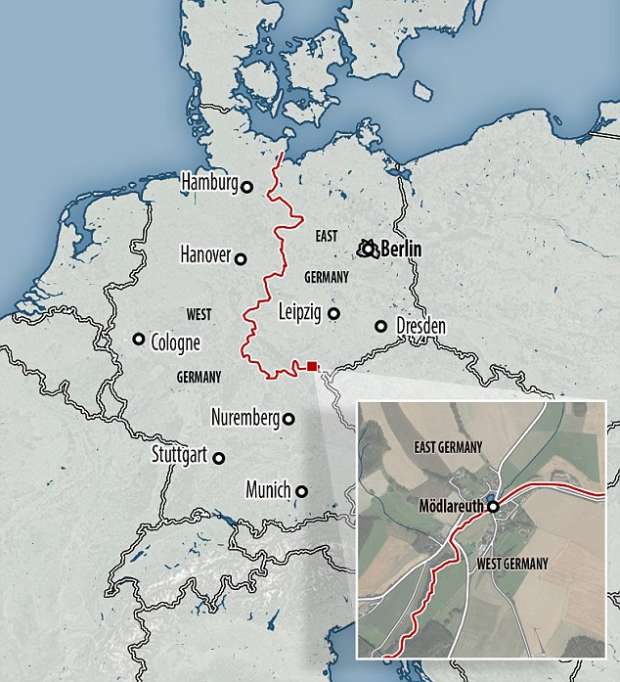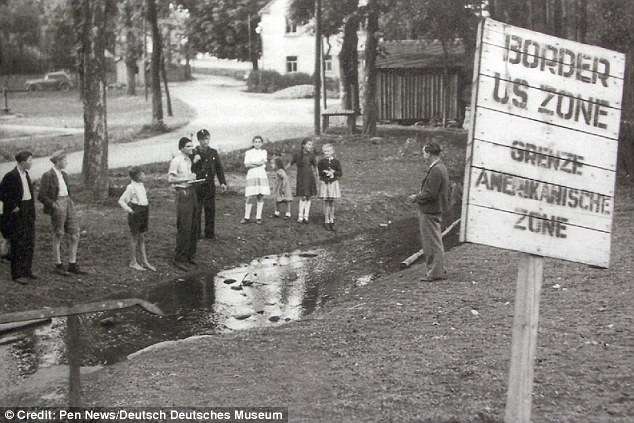Mödlareuth comprises of just 15 households, but its two halves have different mayors, different dialing codes and even different ways of speaking.
The village has straddled the frontier between the German states of Bavaria and Thuringia since 1810, but the border barely mattered until the end of the Second World War.
It was then that Germany was carved in two, with the Thuringian half of Mödlareuth occupied by the Soviets and the Bavarian half by the USA.
A wall, complete with guard towers, mines and machine guns, soon followed - earning Mödlareuth the nickname Little Berlin. Only a portion of that wall now remains, but the tiny community is still a town of two halves.
Jason Johnson, author of Divided Village: The Cold War in the German Borderlands, said the settlement was an 'oddity' in modern Germany.
'The village has two different postal codes, telephone area codes, and mayors,' he said.
'Villagers must pay long-distance fees to place a telephone call to their neighbors across the street.
'The children of the community attend different schools, depending on the state in which they reside.

Mödlareuth is located on the border of the states of Bavaria and Thuringia. It was split in two when Germany was carved up between the Soviet East and allied West in 1945
'Perhaps the most noticeable difference between the two sides of the village is the greeting used.
'In the Bavarian part, one hears the traditional Bavarian greeting 'Grüss Gott' while the standard German 'Guten Tag' is used – with a Thuringian accent – on the other side.
'When asked if they would rather simply unite into one seamless village, the answer among the residents is an adamant and unanimous no.'
Ingolf Hermann, who works at the local museum, agreed that there was still a divide in Mödlareuth but said there were signs of the village coming together.
'The villagers celebrate all the events over the year together in their community centre on the Thuringian side,' he said.
'In the time of the division the people put up two maypoles. Today they put up only one.'

The Mödlareuth border pictured in 1946 when it was just a stream and locals could chat across it. Taken in the West, looking East
The Soviets first occupied Mödlareuth as a whole, taking up a headquarters on the Bavarian side that the locals nicknamed Stalin's Castle. They later withdrew to the Thuringian side and the border between the two halves was closed in 1952, in a bid to stop the exodus from east to west.
Five years after the Berlin wall was built in 1961, Mödlareuth was divided by its own concrete wall, but life in the village was very different to life in the capital.
Mr Johnson, of Trinity University in San Antonio, Texas, said: 'No matter your side in Berlin, half a major city was still on your side.
'Moreover, West Berliners, did not know most or all of the East Berliners.
'In Mödlareuth, numerous villagers knew each other and some were even related. One brother was divided from another across the wall.'
Dividing a place so small had some unintended side effects for the Soviets.
'Five Stasi spies were used to spy on the native eastern villagers,' said Mr Johnson.
'Of course, locals realized quickly that these outsiders were spies and remained guarded toward them.
'In this remote, isolated, tiny community, villagers were able to identify the agents of the Stasi and generally stayed far from their reach.'
The Thuringian side also had to contend with the loss of the village bull, Peter, who lived in the west and was no longer free to visit his eastern girlfriends.

In 1962 a barbed wire fence was installed after the Berlin wall was built in 1961. Photo taken in the west, looking East
'Western villagers refused to allow Peter into East Germany, fearing he would be kept there,' said Mr Johnson. In 1983, George Bush Sr – then vice president under Ronald Reagan – visited Mödlareuth and addressed Western villagers alongside their defence minister, Manfred Wörner.
Echoing President Kennedy's 1963 address in West Berlin, he told them 'Ich bin ein Mödlareuther'.
He later referenced the village in a speech in London, saying: 'If anything, that wall was an even greater obscenity than its eponym to the north.'
On November 9, 1989, the Berlin Wall was opened and its destruction began, but village life proceeded at a more relaxed pace.
'The villagers at the Eastern side asked their mayor for the border to be opened in a meeting on December 5, 1989,' said Mr Hermann.
'Two days later a unit of engineers of the East German border guards started to open the wall.'
By December 9, villagers could freely pass, and photos from that day show locals pouring across the snowy frontier.
Today the village retains part of its wall, as well as guard towers, as an open air museum. But a border remains between the two halves of Mödlareuth.
The Daily Mail
More about: Germany











-1746428211.jpg&h=190&w=280&zc=1&q=100)




































